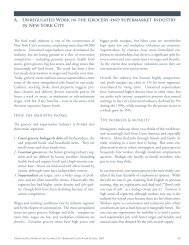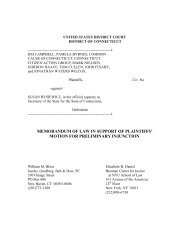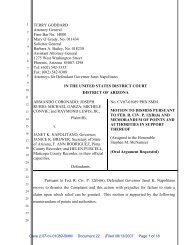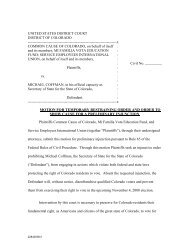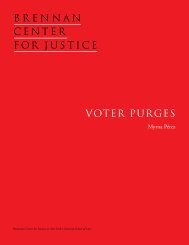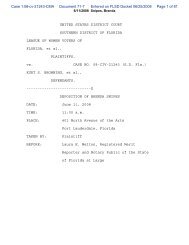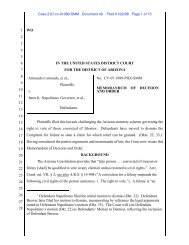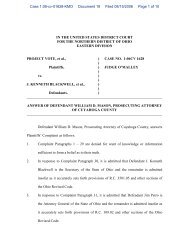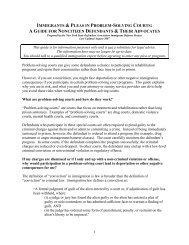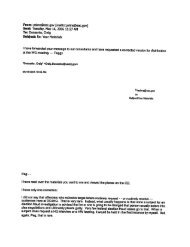causing problems for our communities. Andwe as an organization are looking for ways toimprove that situation.”Location One GalleryWe met with ten artists at Location OneGallery on May 19, 2005. Carol Jacobsen isa video artist and professor. Erika Block isa playwright, theater director, and studentat New York University’s ITP (InteractiveTelecommunications Program). James Robinsonsaid: “I’m not sure if I’m an artist, but I work inpublishing and a lot of the work I’ve been doing“we swim in a remix culture”recently has been creative ways of publishingtext.” Nayda Collazo-Llorens works in variousmedia and is an artist in residence at LocationOne. Heather Wagner and Sebastien Sanz deSantamaria are also artists at Location One;Sanz de Santamaria is part of the arts collective,Flux Factory. Ursula Endlicher works withnew media and the Internet. Clay Shirky is awriter and Web publisher who teaches at ITP.Jamie Allen is a sound artist and musician. Oneparticipant, a recent ITP graduate, asked toremain anonymous.The most striking aspect of this focus groupwas that the artists were able to invoke fair usemore readily than the authors and filmmakersin our previous discussions. As Shirky said,“we swim in a remix culture,” where seekingpermission for every item that goes into themix is neither practical nor logical. JamieAllen likewise doesn’t think of copyright “as anecessary aspect of art”; “I don’t think of ideasthat I produce as being mine per se.” Ouranonymous participant said that she appliesmarkedly different standards to her use of soundsamples, “which I freely appropriate as an artist,”and to copying in her day job, where “I have towatch that stuff diligently for a media companyand it’s like everything has to be approved anddid we pay for it?”Carol Jacobsen added that “artiststraditionally, and contemporary artists especially,are appropriating; and a lot of us do see our ideasas contagious, and want them to be contagious.So we’re not as concerned” about copyright.But as a teacher, she recognizes “a concern oncampuses today about academic integrity –cheating and copying and those kinds of issues.“And I’m realizing ‘Gee, in the art world we kindof appropriate everything.’“In class, we talk about the fact that if it’sin the public domain, and if it’s commercialor news, maybe it’s more accessible and okay– especially if it’s short clips. But I do urgestudents to think about it, especially if they’reborrowing from an artist or an independentsource. I should probably have a lawyer cometo every video class I teach to talk about some ofthese issues. I do talk about the fact that if we’reshowing their videos on campus, there should beno problem. But if they send their videos withappropriated material to a film festival, they mayhave a problem.“I know the university is concerned aboutcopyright issues. We can’t make course packswithout sending for permission for every article,and so many professors I know run to the copymachine and make copies themselves, or to thefew little shops that don’t require copyright. Ihave sought permission from Art in America anddifferent magazines, and they charge and armand a leg, even for articles that I wrote!”Clay Shirky was particularly incensedabout the educational use issue. “NYU hasa phenomenally restrictive fair use policy,occasioned, I believe, by our proximity to themajor media outlets – we’re such a high visibilitytarget in the town where all seven major mediacompanies are headquartered. If you’re lookingfor somebody to sue, we’d be on your list.“It certainly has not been as restrictive in otherplaces that I’ve taught. NYU’s policy is that it’sfair use is if a student is in your office and youthink of something they should read and youtake a book off the shelf and take it down the hall– anything more premeditated than that must gothrough copyright clearance. They make no realdistinction between large and small extractions ofinformation. NYU’s position is that we’re goingto artificially create a safe harbor by creating this26 Will Fair Use Survive?
phenomenally limited circumscription aroundwhat the professor is allowed to do. And thatis mainly a way to force upon the professor therisk of fair use. Most professors don’t actuallyabide by that policy, because it gets in our wayof dealing with our students. What it means is ifI’m ever sued, NYU won’t lift a finger.” 131Ursula Endlicher uses the Internet for allaspects of her work, both gallery installations andonline art. One recent project dealt with spam:“I pulled in a lot of text and names [from spamemails] – all the information I’d gathered overthe years – and I displayed it in an interactivepiece. As you enter a room, you have what I callan identity ticker – it assigns the names of peoplewho have sent me spam. Who are they? They’reprobably not people; they’re probably computergeneratedprograms. I use the text that was inthe body of the email. It gets randomly triggeredby a user who comes in.” She did not questionthe legality of the project, because, she says, ofthe “weirdness” of spam.Heather Wagner created a project usingInternet icons and images. “For a while, I wasgrabbing the little icons that are on Googlenews every day. Under each heading there’sa different icon – U.S. news, sports news,international. So every day I was grabbing themand making a little collage of what was the topnews. It didn’t occur to me that if I ever printedit or showed it someplace, I would need to getanyone’s permission. It’s just stuff that’s out there– a picture of Bush, or the Pope or something.Whereas if it were by a person who created theimage with some artistic intention, I wouldn’tthink I could just grab it.”In an installation piece, Wagner used the textof the Samuel Beckett monologue, Not I. Shethought about seeking permission, but was toldthat the Beckett estate is “notoriously bad. Don’teven try.” The estate requires scrupulous adherenceto Beckett’s stage directions, even down to“the measurements of how far upstage the actorscan be.” In Wagner’s version, there were noactors at all: “I had a computer voice read theplay, and then had it trigger visual things.” AlthoughWagner thought her appropriation wasprobably illegal, there is certainly an argumentthat the fair-use factors would favor her transformativeuse of this iconic 20th century text.Erika Block has had experience in theater,and describes her knowledge of fair use as “sortof old school – how many minutes of music canyou use without getting rights?” She said thatshe has “freely used music, sounds, and verses inproduction,” adding: “I’m religious about givingattribution; and I figure that working for a littlenonprofit, where 3,000 people are going to seethe show, is really different from a commercialproject with larger audiences.”She has also used samples in digital artwork.A current project called “Dirty Little Stories”is a digital montage, adapted from a theaterpiece, using clips of dialog from classic filmnoir. “For the theater production, we basicallyrented VCR tapes and created digital recordings.I integrated the clips with original photos intoan interactive montage.” She is aware of thecopyright implications, but doesn’t know theanswers. “Some of them are really quick clips;some of them are longer. Is it two minutes formusic fair use? There’s some number. I can’t evenremember it. Do you know the answer? I haveto decide if it’s worth using that material beforeI go further with distributing this work. I thinkI would probably use it and give attribution.”James Robinson’ recent project, “TheQuotomatic,” calls upon a digital archiveof quotations using a supermarket bar codescanner. “Instead of quoting a price for anobject, it gives you a quotation. It recognizeswhat the object is, like a can of corn, and thenit’ll search Bartleby.com, which is an onlinearchive of 80,000 quotations. It looks for aquote that is relevant to a can of corn. Thenprints it out on a mailing label.“I’m sure a lot of the work in the archive iscopyrighted, but I’m not concerned with that.I’m not even really concerned with fair use.That’s changed a bit since I came to ITP, whereI had artistic license. Having worked in thepublishing world, I’ve come to the conclusionthat copyright is a political tool. Once you getinto the legal game, it’s over.”Robinson elaborated by describing hisinvolvement with BaseballLibrary.com, anonline archive of baseball history. “We had afeature that we were doing for CBS Sports Linecalled ‘Believe It or Else.’ We received a ceaseand desist letter from the ‘Ripley’s Believe ItBrennan Center for Justice 27
- Page 1 and 2: WILLFAIR USESURVIVE?Free Expression
- Page 3 and 4: WILLFAIR USESURVIVE?Free Expression
- Page 5: ContentsExecutive Summary . . . . .
- Page 9 and 10: unhappy years of World War II.” 1
- Page 11 and 12: Although §512 does allow an ISP
- Page 13 and 14: music, distance learning, interlibr
- Page 15 and 16: CHAPTER 1The Legal LandscapeThis ch
- Page 17 and 18: Court’s “Oh, Pretty Woman” de
- Page 19 and 20: the public would be confused about
- Page 21 and 22: CHAPTER 2Quoting Sartre, Using Prok
- Page 23 and 24: owned by Gallimard [the French publ
- Page 26 and 27: well, this and this person gave it
- Page 28 and 29: you can do with the pages of Time a
- Page 30 and 31: going to start writing letters for
- Page 34 and 35: or Not’ people. So we took it dow
- Page 36 and 37: The American Pool Players Associati
- Page 38 and 39: “Paris Hilton Sex Tape” 150 (ho
- Page 40 and 41: howardhallis.com,” a comedy and c
- Page 42 and 43: legitimate borrowing of protected m
- Page 44 and 45: Dan Hamilton, managing editor of th
- Page 46 and 47: legal action as long as eInfoworld
- Page 48 and 49: At that point, Cox took to the blog
- Page 50 and 51: her books, but not created by Anne
- Page 52 and 53: CHAPTER 5Internet Infidels and Home
- Page 54 and 55: she attributed to the many form let
- Page 56 and 57: “Without his permission, the gove
- Page 58 and 59: eproducing an artwork in a book wit
- Page 60 and 61: ConclusionWhat can we learn from th
- Page 62 and 63: Reiff thought that instead, the gov
- Page 64 and 65: Endnotes1 Mattel v. Walking Mountai
- Page 66 and 67: 48 See Katie Dean, “Eyes on the P
- Page 68 and 69: 109 Not an exact quote. See Alan Al
- Page 70 and 71: 149 http://msophelia.blogspot.com/p
- Page 72 and 73: 215 “MBA Legal Defense Initiative
- Page 74 and 75: lank left hand page
- Page 76: 161 Avenue of the Americas12 th Flo



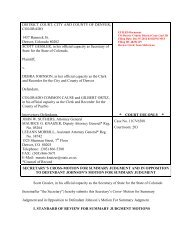
![Download the Letter [PDF] - Brennan Center for Justice](https://img.yumpu.com/50139248/1/190x245/download-the-letter-pdf-brennan-center-for-justice.jpg?quality=85)
